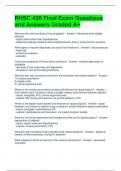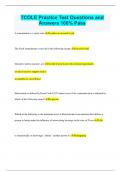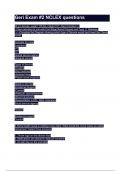RHSC 420 Final Exam Questions
and Answers Graded A+
What are the main functions of the amygdala? - Answer-- influences drive-related
behavior
- higher level control over hypothalamus
- subjective feelings related to drive-related behavior (fear is most common emotion)
What types of visceral responses can result from emotions? - Answer-- blood pressure
- heart rate
- endocrine response
- salivation
Cause and symptoms of Kluver-Bucy syndrome. - Answer-- bilateral destruction of
amygdala
- decrease in fear responses and aggression
- increase in sexual and eating behaviors
What are the main structures involved in the motivation and reward system? - Answer-
1) nucleus accumbens
2) septal nuclei
3) ventral tegmental area
Where is the nucleus accumbens located and what are its inputs/outputs? - Answer--
most anterior part of striatum, where caudate nucleus and putamen become adjacent
- inputs: amygdala, PFC, ventral tegmental area
- outputs: DM nucleus of thalamus (via ventral pallidum), PFC
Where is the septal nuclei located and what are its inputs/outputs? - Answer-- basal
forebrain, just inferior to anterior corpus callosum, closely related to septum pellucidum
- inputs: amygdala, hypothalamus, RF
- outputs: hypothalamus and brainstem, via medial forebrain bundle
Where is the ventral tegmental area located and what are its inputs/outputs? - Answer--
tegmentum of midbrain
- inputs: septal nuclei and hypothalamus
- outputs: nucleus accumbens, PFC
What are main functions of the motivation and reward systems? - Answer-- pleasure,
reward, reinforce learning, involved in addiction
What happens if there are lesions to the nucleus accumbens? - Answer-- decreased
motivation
,What is cognition? - Answer-- ability to process info, includnig perception learning,
remembering, judging, problem solving
What functions are the dominant and non-dominant hemispheres responsible for? -
Answer-- dominant: language perception and speech
- non-dominant: spatial perception, recognition of faces, music
Which hemisphere is more dominant for L and R handed people? - Answer-L
hemisphere - most R handed people, 70% L handed people
R hemisphere - 15% of L handed people
both - 15% L handed people
What are the two streams of visual processing and their functions? - Answer-1) the
"What stream" (ventral stream) - object recognition
2) the "where stream" (dorsal stream) - spatial awareness of visual input
What is visual agnosia? - Answer-- problems with visual object recognition, even though
vision is intact
What causes visual agnosia? - Answer-- lesions in inferior temporal lobe and ventral
occipital cortex (lingual and fusiform gyri)
- usually bilateral or sometimes right-sided
What are the symptoms of visual agnosia? - Answer-- can recognize objects by touch or
sound, but not sight
- see small details, but not overall shape
Describe the "what" pathway. - Answer-1) V1 - info about contour, orientation, colour,
brightness for each point in visual field
2) V2 - combines info fr V1 to extract colour and form info
3) V4 - form, colour, texture
4) TE - representation of general form of object
What is prosopagnosia? - Answer-- inability to recognize faces, even family members
- often cannot recognize picture of self
What damage causes prosopagnosia? - Answer-- damage in right fusiform gyrus
(fusiform face area)
- often accompanied by level of object agnosia
Describe the pathway of the "where" stream. - Answer-V1/V2 same as "what" stream
V3- role in processing global motion
MT (V5) - role in processing motion
What causes Balint's syndrome? - Answer-- damage to parietal lobes
, What are the symptoms of Balint's syndrome? - Answer-- ocular apraxia - difficulty
moving eyes to engage visual targets, esp in visual field contralateral to lesion
- simultanagnosia - inability to perceive multiple objects at same time
- optic ataxia - inaccuracy reaching for visual targets with arm contralateral to lesion
(misreaching)
What causes neglect? - Answer-- damage to posterior parietal cortex (commonly right
side)
What are the signs of neglect? - Answer-- failure to attend to portions of space
- if R side lesion, pts do not see objects on left side
- unaware of left side of own body
- difficulty turning left
Where are the circuits for the production and comprehension of speech? - Answer--
localized in left hemisphere
What parts of speech is the right hemisphere involved with? - Answer-- expression
- recognition of emotion in tone of voice
- prosody
- normal rhythm and stress in speech
What Brodmann area is associated with speech production? - Answer-- Broca's area in
inferior left frontal lobe, just adjacent to face area of primary motor cortex
What happens if here is damage to Broca's area? - Answer-- Broca's aphasia - slow,
laborious, nonfluent speech or completely mute
- aka expressive aphasia or motor aphasia
- more difficulty with function words (a, the, some, in) and less difficulty with content
words (nouns, adjectives, verbs)
What Brodmann area is associated with speech comprehension? - Answer-- Wernicke's
area in left superior temporal gyrus
What happens if there is damage to Wernicke's area? - Answer-- fluent aphasia
- patients have poor speech comprehension, able to produce fluent, but meaningless
speech
- often unaware of deficit
What are the main functions of the vestibular system? - Answer-- provide us with our
sense of balance and head position
What are the peripheral vestibular organs? - Answer-- semicircular canals
- otolith organs







